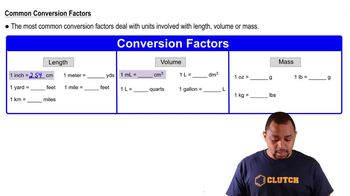Assume that the electrical conductivity of a solution depends on the total concentration of dissolved ions and that you measure the conductivity of three different solutions while carrying out titration procedures: (a) Begin with 1.00 L of 0.100 M KCl, and titrate by adding 0.100 M AgNO3. (b) Begin with 1.00 L of 0.100 M HF, and titrate by adding 0.100 M KOH. (c) Begin with 1.00 L of 0.100 M BaCl2, and titrate by adding 0.100 M Na2SO4. Which of the following graphs corresponds to which titration?
Ch.4 - Reactions in Aqueous Solution
Chapter 4, Problem 46a
How many moles of solute are present in each of the following solutions? (a) 35.0 mL of 1.200 M HNO3
 Verified step by step guidance
Verified step by step guidance1
Determine the formula for calculating moles from molarity and volume: \( \text{moles} = \text{molarity} \times \text{volume in liters} \).
Convert the volume from milliliters to liters: \( 35.0 \text{ mL} = 0.0350 \text{ L} \).
Substitute the given values into the formula: \( \text{moles} = 1.200 \text{ M} \times 0.0350 \text{ L} \).
Perform the multiplication to find the number of moles.
Ensure the units are consistent and the calculation is correct.

Verified video answer for a similar problem:
This video solution was recommended by our tutors as helpful for the problem above.
Video duration:
51sWas this helpful?
Key Concepts
Here are the essential concepts you must grasp in order to answer the question correctly.
Molarity (M)
Molarity is a measure of concentration defined as the number of moles of solute per liter of solution. It is expressed in moles per liter (mol/L). Understanding molarity is crucial for calculating the amount of solute in a given volume of solution, as it directly relates the volume of the solution to the number of moles present.
Recommended video:
Guided course

Molarity Concept
Volume Conversion
In chemistry, it is often necessary to convert volumes from milliliters (mL) to liters (L) when working with molarity. Since 1 L equals 1000 mL, converting mL to L involves dividing the volume in mL by 1000. This conversion is essential for accurately applying the molarity formula to determine the number of moles of solute.
Recommended video:
Guided course

Common Conversion Factors
Calculating Moles from Molarity
To find the number of moles of solute in a solution, the formula used is: moles = molarity × volume (in liters). This relationship allows for the straightforward calculation of moles when both the molarity and the volume of the solution are known. It is a fundamental concept in stoichiometry and solution chemistry.
Recommended video:
Guided course

Molar Mass Calculation Example
Related Practice
Textbook Question
Textbook Question
Based on the positions in the periodic table, which of the following reactions would you expect to occur? (a) Red+ + Green → Red + Green+ (b) Blue + Green+ → Blue+ + Green (c) Red + Blue+ → Red+ + Blue
Textbook Question
The following two redox reactions occur between aqueous cations and solid metals. Will a solution of green cations react with solid blue metal? Explain.
(a)
(b)
Textbook Question
How many moles of solute are present in each of the following solutions? (b) 175 mL of 0.67 M glucose (C6H12O6)
3
views
Textbook Question
How many grams of solute would you use to prepare each of the following solutions? (a) 250.0 mL of 0.600 M ethyl alcohol (C2H6O)
2
views
Textbook Question
How many grams of solute would you use to prepare each of the following solutions? (b) 167 mL of 0.200 M boric acid (H3BO3)
2
views
